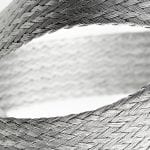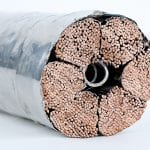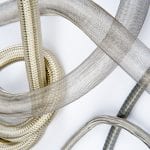Motors, induction heaters, transformers and other devices with wound wire coils pose a problem to designers. Because they are not “perfect,” they suffer losses that show up as heat. New England Wire Technologies has developed a technology that saves time, money and gives design engineers and manufacturers proven, UL-listed solutions for building safer wire coils.
Unwanted Heat, Many Sources
Wire heats up when an electrical current passes through it due to its natural resistance. Because coils require long lengths of wire, heat produced due to resistance can be a significant factor. Increasing the wire gauge reduces resistance and resulting heating, but also increases the cost, size and weight of the coil. The amount of heat produced is in direct relation to the wire’s natural resistance.
However, natural resistance isn’t the only reason coiled wire heats up. A coil packs a lot of copper into a confined space. When layers of conductors are wound over one another, they can’t cool as efficiently because heat from one part of the wire will radiate to other parts of the wire and the winding components, rather than dissipate primarily into the open air. Further, heated air that may be flowing over one part of the coiled wire may flow over another part of the coil instead of away from the coil.
In alternating current applications, the “skin effect” can significantly contribute to unwanted heat. At operating frequencies of 60 Hz and above, current tends to flow along the surface of a conductor due to eddy currents induced by the changing electromagnetic field that alternating currents produce. Most current flow occurs along the surface of the conductor down to its’ skin depth. It is only this area of the conductor that is transmitting the electrical current. With most of the current flowing through only a small cross-section of the wire, the skin effect increases the wire’s AC resistance in direct proportion to the frequency of the current. For example, with a 5-kHz frequency applied through a copper magnet wire, the current density is largely confined to the outer one millimeter of the conductor. At a frequency of 1 MHz, skin depth is approximately 0.076mm.
The “proximity effect” further contributes to winding wire inefficiency for electrical conductors used as winding wires in alternating current applications. If two wires carrying the same alternating current lie parallel to one another, the AC current creates a magnetic field which induces eddy currents in adjacent conductors that alters the overall distribution of current flowing through them. The net effect of the current is concentrated only in the areas of the conductor furthest away from nearby conductors carrying current in the same direction. The proximity effect and skin effect can make solid strand winding wires very inefficient and can cause significant heat in a winding.
“Electrical Insulation System” Defined
Excessive heat from any of these sources can damage the insulating material used to keep each coil winding insulated from the components used in the winding. Use of an Electrical Insulation System (EIS) will help to prevent such damage from occurring.
An EIS is a combination of electrical insulating materials (EIM) that have been tested for compatibility at specific maximum temperatures. Engineers usually choose EIM’s (magnet wire film insulations, encapsulants, varnishes, etc.) based upon expected hot spot temperature design limits. However, at temperatures greater than about 100°C, individual insulating materials begin to react chemically with one another. Such reactions can affect dielectric strength, flame resistance, ignition resistance and lead to premature product failure, fire hazards and product liability issues. Today, Electrical Insulation Systems play an important role in product safety and have been formalized as global industry standards.
These chemical reactions and incompatibilities can’t be predicted through mathematical modeling or the stated temperature rating of the various insulating materials. EIM’s need to be tested over long periods of time (usually up to seven months) at three different temperatures to determine the maximum temperature that the combination of materials can safely operate. During the full thermal aging process samples are subjected to a cycling program that includes mechanical stress, cold shock, and moisture exposure. This sort of rigorous long term testing is expensive to conduct. Chemical compatibility testing (CCT) is usually required to add non-electrical insulating materials (NIM) that are used typically in mechanical or thermal conduction capacities that a customer wants to use in conjunction with an existing electrical insulation system. Examples of NIM’s include balancing compounds, potting compounds, sleeving and tubing, spacers, wedges, tie cords, etc. This is under the scope of UL standard 1446 and a short duration (two week) test is required.
Choose an Approved EIS from NEWT
NEWT offers a versatile, pre-approved, Electrical Insulation System recognized by Underwriters Laboratories for use in the construction of transformers, motors and coils. The NE-F1 electrical insulation system from NEWT is Class F (155°C) rated and has an OBJS2 file number of E231977.
To view NEWT’s full NE-F1 table of offerings, click here.
The NE-F1 system eliminates the need for lengthy and expensive component testing required to develop your own EIS. It’s versatile and provides a large selection of EIM’s and NIM’s to support most any application.
NEWT’s manufacturing expertise dates back to the 1890’s when we were the first company in the USA to manufacture Litz wire on a commercial basis. With our extensive experience with UL and other regulatory agencies, our NE-F1 system provides the necessary approvals to give our customers a turnkey EIS that can be used across a wide range of design projects.
NEWind® Specialty Winding Wire
NEWind® is special winding wire that replaces traditional forms of single end copper or magnet wire. NEWind® results in more efficient devices that you bring to market. Your products can be smaller and less costly to make and you’ll get them to market much faster because you don’t have to endure long months of testing. NEWind® has been tested in NEWTC’s NE-F1 (155°C) electrical insulation system as an EIM of the NE-F1 Class F (155°C) EIS. It was developed to save time in winding coils, to reduce coil size, and to cut costs. With NEWind®, no additional ground or inter-winding insulation is required to separate NEWind® from other enameled magnet wire windings, or from grounded or dead metal. This allows for a faster winding assembly process and reduces the number of inventoried materials needed to manufacture the product.
In addition to Underwriters Laboratories (UL), other agencies such as the International Electrotechnical Commission (IEC), and Verband der Elektrotechnik (VDE) have published their own testing standards and requirements that manufacturers can use to verify the safety and compatibility of winding wires in the intended application. NEWind® is compliant with the following standards:
- • UL 1446 Systems of Insulating Materials – General
- • UL2353 Single- and Multi-Layer Insulated Winding Wire
- • UL/IEC 60950-1 Information Technology Equipment
- • IEC60601-1 Medical Electrical Equipment
- • UL 758 UL Appliance Wiring Material
NEWind® constructions offer a choice of three extruded fluoropolymers – ETFE, FEP, and PFA and can be provided using any conductor material. The extruded layers can be provided as Basic Insulation (one layer), Supplementary Insulation (two layers), or Reinforced Insulation (three layer). Supplementary and reinforced insulations assure defects in any one layer does not compromise the insulating ability of the composite extrusions. As a result, motors and transformers can be manufactured without additional insulation, thus reducing their cost and size.
Litz Wire Is a NEWind® Option, Too
Litz wire is made by weaving or twisting many fine gauge individually insulated magnet wires together in a specific pattern that distributes alternating current flow equally through the entire cross section of the conductor. As a result, litz wire minimizes two kinds of AC losses—skin and proximity effects—which makes the conductor inefficient and generate significant unwanted heat in a winding. Your winding will operate more efficiently with litz wire, especially at higher operating frequencies. It also makes your winding easier to work with because you don’t have to use interleaving insulation; it’s already part of your winding wire.
NEWind® Litz constructions are especially suited for the following applications:
• Induction heating
• Transformers
• Electric motors
• Military applications
• High end audio
• Medical winding applications (electro-surgical tools, for example)
• Power generation
• Pumps
• Domestic appliances
• Automotive
• Relays
• Solenoids
• Electromagnets
• Inductors
• Control devices
Save Time, Cut Costs with Our EIS
You can develop your own EIS at substantial time and cost. Or, you can adopt an approved NE-F1 Class F (155°C) system from NEWT. You’ll not only enjoy the benefits outlined above but also receive expert support if you may be unsure how EIS technology works. We look forward to sharing our expertise with you. Please contact us to learn how you can begin using this technology today.
Editor’s Note: Article contributed by James Clough and Richard Trahan, Design Engineer staff members at New England Wire Technologies.





















